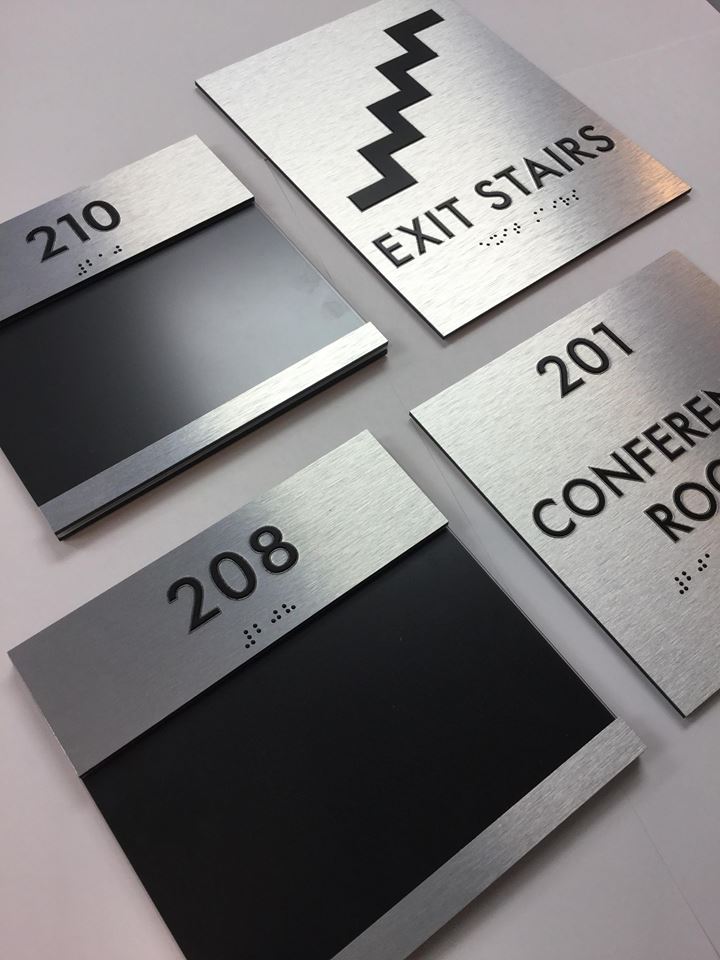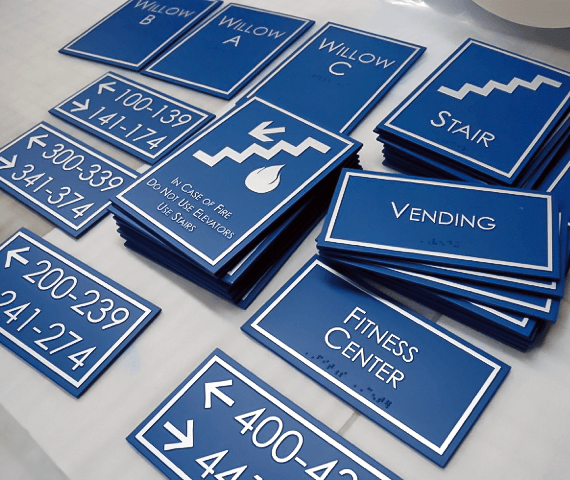Just How ADA Signs Enhance Ease Of Access for Everyone
Just How ADA Signs Enhance Ease Of Access for Everyone
Blog Article
Discovering the Key Functions of ADA Indications for Improved Availability
In the world of availability, ADA indications act as silent yet powerful allies, ensuring that spaces are comprehensive and navigable for individuals with disabilities. By integrating Braille and responsive aspects, these indications break barriers for the visually damaged, while high-contrast color pattern and understandable typefaces satisfy diverse visual requirements. Furthermore, their tactical placement is not approximate however rather a computed effort to facilitate smooth navigating. Yet, past these attributes exists a much deeper narrative concerning the advancement of inclusivity and the continuous dedication to producing equitable rooms. What much more could these signs symbolize in our pursuit of global access?
Importance of ADA Conformity
Making certain conformity with the Americans with Disabilities Act (ADA) is critical for cultivating inclusivity and equivalent access in public areas and workplaces. The ADA, established in 1990, mandates that all public centers, employers, and transportation solutions suit people with impairments, guaranteeing they appreciate the same legal rights and chances as others. Conformity with ADA criteria not only fulfills legal responsibilities yet additionally enhances an organization's online reputation by demonstrating its commitment to diversity and inclusivity.
Among the vital elements of ADA conformity is the implementation of easily accessible signage. ADA indications are made to ensure that individuals with specials needs can easily navigate via buildings and rooms. These signs have to stick to specific guidelines concerning size, font, color contrast, and positioning to assure presence and readability for all. Effectively implemented ADA signage aids remove obstacles that individuals with specials needs often encounter, thus promoting their independence and confidence (ADA Signs).
Additionally, adhering to ADA laws can alleviate the risk of prospective penalties and legal repercussions. Organizations that fall short to adhere to ADA guidelines might encounter fines or suits, which can be both monetarily difficult and damaging to their public picture. Thus, ADA conformity is integral to promoting an equitable atmosphere for every person.
Braille and Tactile Aspects
The unification of Braille and tactile aspects into ADA signs personifies the principles of availability and inclusivity. It is typically placed beneath the corresponding message on signage to ensure that individuals can access the details without aesthetic assistance.
Tactile elements extend past Braille and consist of elevated signs and characters. These elements are developed to be discernible by touch, allowing people to recognize space numbers, bathrooms, departures, and other crucial areas. The ADA establishes certain guidelines concerning the size, spacing, and positioning of these responsive aspects to optimize readability and make certain uniformity across different settings.

High-Contrast Shade Plans
High-contrast color systems play an essential role in boosting the presence and readability of ADA signs for individuals with aesthetic disabilities. These systems are crucial as they make best use of the difference in light reflectance in between text and background, making sure that signs are conveniently discernible, even from a range. The Americans with Disabilities Act (ADA) mandates the use of details color contrasts to suit those with restricted vision, making it an essential facet of compliance.
The efficiency of high-contrast colors lies in their capacity to stand apart in numerous lighting problems, consisting of dimly lit atmospheres and locations with glare. Commonly, dark text on a light background or light message on a dark background is utilized to attain optimal contrast. As an example, black message on a white or yellow history gives a stark visual distinction that assists in quick recognition and understanding.

Legible Fonts and Text Dimension
When thinking about the design of ADA signage, the selection of understandable fonts and suitable text dimension can not be overemphasized. The Americans with Disabilities Act (ADA) mandates that font styles should be sans-serif and not italic, oblique, manuscript, highly ornamental, or of uncommon form.
According to ADA standards, the minimum message elevation ought to be 5/8 inch, and it needs to boost proportionally with seeing distance. Uniformity in text size contributes to a cohesive visual experience, aiding people in navigating environments effectively.
Furthermore, spacing in between lines and letters is important to legibility. Ample spacing stops characters from showing up crowded, boosting readability. By adhering to these criteria, designers can dramatically improve access, guaranteeing that signs serves its designated objective for all individuals, no matter their aesthetic capabilities.
Efficient Positioning Strategies
Strategic positioning of ADA signs is important for taking full advantage of access and ensuring compliance with lawful criteria. Appropriately located signs direct her response people with handicaps effectively, assisting in navigating in public spaces. Key considerations include visibility, height, and distance. ADA guidelines state that indications must be installed at an elevation between 48 to 60 inches from the ground to ensure they are within the line of sight for both standing and seated individuals. This common elevation variety is important for inclusivity, making it possible for mobility device customers and people of differing elevations to gain access to info effortlessly.
Furthermore, signs have to be put surrounding to the latch side of doors to allow simple identification prior to entry. Uniformity in sign positioning throughout a facility boosts predictability, decreasing complication and enhancing total individual experience.

Conclusion
ADA indications play an important function in promoting ease of access by integrating features that address the needs of individuals with handicaps. These components jointly promote an inclusive environment, underscoring the importance of ADA conformity in making certain equivalent gain access to for all.
In the realm of availability, ADA indications serve as silent yet effective allies, making certain that areas are comprehensive and accessible for individuals with disabilities. The ADA, established in 1990, mandates that all public centers, employers, and transport solutions fit individuals with handicaps, guaranteeing they delight in the same civil liberties and chances as others. ADA Signs. ADA signs look at this web-site are made to make sure that individuals with disabilities can quickly navigate via areas and buildings. ADA standards state that indicators must be mounted at a height between 48 to 60 inches from the ground to guarantee they are within the line of sight for both standing and seated individuals.ADA indicators play an important function in advertising ease of access by integrating features that attend to the demands of people with disabilities
Report this page